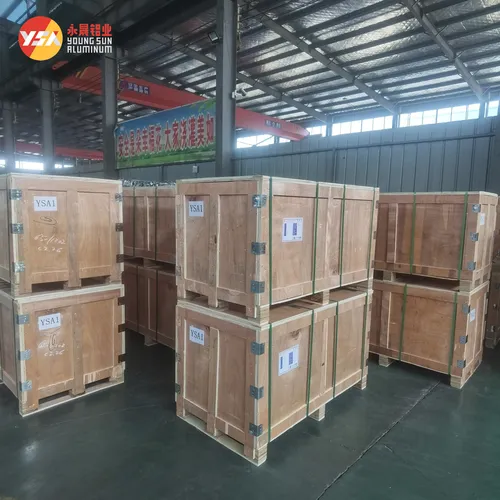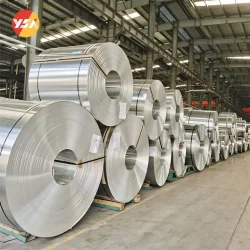Aluminum Foil Storage & Transportation
Aluminum foil rolls should be protected by proper packaging to prevent damage and environmental impact. Common packaging methods include overpacking with materials such as wooden crates, cardboard boxes or wrapping paper to ensure the integrity and safety of the coil.

Wooden box
In wooden crate packaging, it is important to choose the right material, prevent deformation and secure it properly.
Choose high-quality, strong and durable wood such as plywood, solid wood or wooden frames. Ensure that the wood meets international standards and transportation requirements. Ensure that the structure of the crate is well designed to withstand stress and vibration during transportation.
Consider the use of reinforced supports or strengthened joints to increase the strength and stability of the wooden crate. Adding reinforcement corners to the corners of a wooden crate can improve the stability and resistance to deformation of the crate. These reinforcing corners can be made of metal or plastic material and fixed to the corners of the crate.
Ensure that the lids of wooden crates are securely closed and sealed with appropriate sealing materials to prevent packing materials and aluminum foil rolls from accidentally loosening or falling apart. Securely fasten the crate using high strength straps to ensure that the lid and packing materials do not come loose or move.
The straps should be tightly secured, but avoid over-tensioning to prevent excessive pressure from being applied to the aluminum foil rolls, increasing the overall stability of the crate and preventing movement of the components. Use the appropriate size and type of nails or screws to securely attach the components of the crate together. Ensure that the fixings are strong and secure to prevent the crate from loosening during transportation.
In addition to wood, other packaging materials such as bubble wrap can be used as internal padding and protective layers. These materials provide additional cushioning and protection, reducing the effects of deformation and vibration on the cargo.

Foam paper wrapping
Before aluminum foil rolls are placed in wooden crates, reliable manufacturers often choose to wrap the rolls in foam paper and secure them with a combination of straps. The rolls are carefully wrapped in foam paper to provide an extra layer of cushioning and protection, further adding to the protection and stability of the rolls.
By combining wooden crates, foam paper wrapping and tie-down securing, more comprehensive protection and stability can be provided to ensure that the aluminum foil rolls are safe and undamaged during trans-oceanic transportation and storage.

Temperature control
Another point to keep in mind when aluminum foil storage and transportation is temperature control. Transportation and storage of aluminum foil rolls should avoid extreme temperature variations and excessive temperatures. High temperatures may cause the aluminum foil to soften and deform, while low temperatures may make the coil brittle. Therefore, transportation and storage should be carried out within a controlled temperature range as far as possible.
The physical properties of aluminum foils usually remain stable over a wide temperature range and do not change significantly.
- Minimum withstand temperature:
Aluminum foils can usually be used normally at very low temperatures without significant changes in physical properties. In general, aluminum foils remain flexible and malleable at temperatures as low as -30°C (-22°F). Aluminum foil melting temp is approximately 660°C.
- Maximum withstand temperature:
Aluminum foil can be used normally at relatively high temperatures, but the exact temperature at which it can be used is influenced by a number of factors, such as the thickness of the foil, its purity, the treatment process and the surrounding environment. As a general rule, the upper temperature limit for the use of aluminum foil is usually around 200°C (392°F), above which the foil may deform, soften or lose its properties.
Other Notes
Aluminum foil storage place is usually dry, ventilated environment free of corrosive gases. Avoid prolonged exposure to direct sunlight and keep away from hazardous substances such as flammable items and chemicals.
During aluminum foil storage and transportation, it is necessary to avoid contact with sharp objects, heavy objects or other items that could cause mechanical damage. This can be achieved by proper stacking, using suitable protection and paying attention to handling methods.
Reliable logistics partners with long-term stable cooperation ensure that aluminum foil rolls are properly handled and protected during transoceanic transportation. Reasonable arrangement of transportation time and routes to ensure safe and timely delivery of goods.
FAQ: Aluminum Foil Melting Temp
Aluminum foil melting temp is approximately 660 °C or 1220 °F. At aluminum foil melting temp, aluminum foil transitions from a solid state to a liquid state. It’s important to note that the melting temperature can vary slightly depending on the specific alloy and impurities present in the aluminum foil.

FAQ: What should I do if the wooden box gets wet?
If the wooden packaging is affected by moisture during transit
- Inspection and assessment:
If the crate is found to be wet upon arrival at the destination, promptly inspect the condition of the crate and the cargo inside. Assess the degree of dampness and whether the goods have been damaged.
- Preventing further damage:
If the interior of a crate is found to be wet, take prompt action to prevent further damage. The wet crate can be moved to a dry, ventilated area and any wet packing materials removed as soon as possible. If there are wet or damaged goods, promptly organize and dry them to prevent further corrosion or damage.
- Contact the logistics company:
Contact the logistics company promptly when wetting problems are detected. If the goods are severely damaged, an insurance claim may need to be filed. Communicate with the logistics company and insurance provider to submit the claim procedure in a timely manner.

